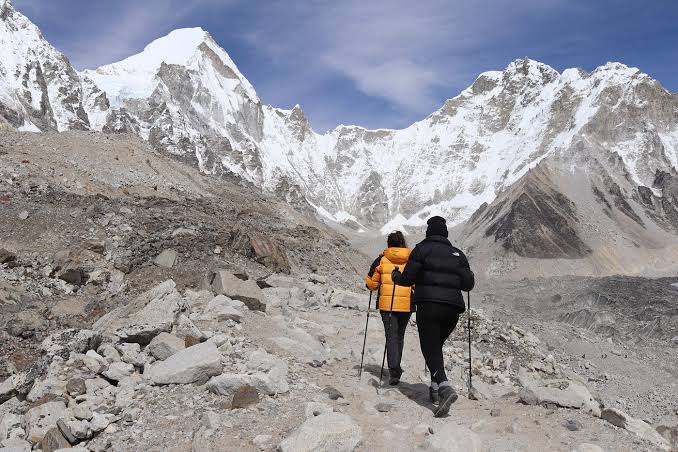Packing for the Everest Base Camp trek requires careful consideration and planning due to the challenging conditions and high altitudes encountered along the way. The ultimate packing list ensures that you are well-prepared for both the physical demands of the trek and the unpredictable weather. Start with a sturdy, comfortable trekking backpack that can hold all your essentials. A pack with a capacity of 50-60 liters is typically sufficient. It should be equipped with adjustable straps to ensure a snug fit and distribute weight evenly.
Clothing is crucial for adapting to the changing temperatures. Layering is key, so pack moisture-wicking base layers, thermal mid-layers, and a waterproof, windproof outer shell. The weather can vary greatly, from sunny mornings to freezing evenings, so having versatile clothing options is essential. Include a good quality fleece jacket, insulated down jacket, and waterproof pants. A wide-brimmed hat, gloves, and a warm beanie will protect against the cold.
Footwear is another critical consideration. Invest in well-fitting, waterproof trekking boots with good ankle support and adequate insulation. Everest base Camp Trekking Consider bringing gaiters to protect your boots and lower legs from snow and debris. Alongside your trekking boots, pack a pair of comfortable camp shoes for relaxing at the end of each day.
For personal items, bring a high-quality sleeping bag rated for sub-zero temperatures and a sleeping pad for added insulation and comfort. A lightweight, compact tent might be necessary if you plan to camp independently, though many trekkers stay in teahouses.
Hydration is vital, so carry a reliable water bottle or hydration system. A water filter or purification tablets are also necessary for treating water along the trail. High-energy, nutritious snacks such as nuts, granola bars, and dried fruits can provide essential fuel during the trek.
Sun protection cannot be overlooked. Pack a high-SPF sunscreen, lip balm with SPF, and a good pair of UV-protection sunglasses. A personal first-aid kit with essentials like blister treatment, pain relievers, and any personal medications is also recommended.
In addition, don’t forget trekking poles for stability on rough terrain, a camera for capturing the stunning vistas, and power banks or solar chargers to keep your electronic devices powered. Essential documents, such as your passport, trekking permits, and insurance details, should be kept in a waterproof pouch.
By meticulously planning your packing list, you ensure that you are well-equipped to handle the demanding conditions of the Everest Base Camp trek, allowing you to focus on the adventure and enjoy the breathtaking landscapes.
Introduction
Embarking on the Everest Base Camp trek Itinerary requires meticulous preparation and thoughtful packing to ensure a safe and enjoyable adventure in one of the world’s most rugged terrains. The extreme altitudes and variable weather conditions demand specialized gear and clothing. An efficient packing strategy involves understanding the essential items you’ll need for the trek, balancing functionality and comfort. From protective clothing to reliable equipment, each item plays a crucial role in your journey. Being well-prepared not only enhances your trekking experience but also ensures you are equipped to handle the unpredictable conditions of the Himalayan region. Proper preparation helps mitigate risks associated with high-altitude trekking and contributes to a more enjoyable and successful adventure. By focusing on essential gear, appropriate clothing layers, suitable footwear, and comfortable sleeping gear, you can navigate the Everest Base Camp trek with confidence and ease.
Essential Gear
For the Everest Base Camp trek, selecting the right gear is pivotal to ensure safety and comfort throughout the journey. A high-quality trekking backpack with a capacity of 50-60 liters is essential, offering enough space to carry all necessary items while maintaining balance and comfort. Trekking poles are highly recommended to provide stability and reduce strain on steep and uneven terrain. Additionally, a durable, lightweight water bottle or hydration system is crucial for staying hydrated. Water purification tablets or a filter will ensure access to clean drinking water. A comprehensive first-aid kit, including blister treatment, pain relievers, and personal medications, is essential for addressing minor injuries and health issues. Don’t forget a reliable headlamp or flashlight with extra batteries, as well as power banks or solar chargers to keep electronic devices operational. A camera or smartphone will help capture the stunning vistas along the trek. Finally, carry essential documents such as your passport, permits, and insurance details in a waterproof pouch to protect them from the elements.
Clothing Layers
Layering is a key strategy for managing the diverse weather conditions on the Everest Base Camp trek. Begin with moisture-wicking base layers that keep sweat away from your skin and provide warmth. These layers are crucial for maintaining comfort and preventing chills. Over this, wear insulating mid-layers such as fleece jackets or down vests to retain body heat. These layers should be breathable to allow for temperature regulation during physical exertion. For the outermost layer, a waterproof and windproof shell is necessary to protect against rain, snow, and strong winds. Ensure that your outer layer is durable and provides adequate protection against the elements. In addition to these core layers, pack a wide-brimmed hat, gloves, and a warm beanie for added protection against cold temperatures. Combining these layers effectively allows for flexibility in adjusting to varying temperatures and weather conditions, ensuring that you remain comfortable throughout the trek.
Footwear
Proper footwear is critical for the Everest Base Camp trek due to the challenging and variable terrain. Invest in high-quality, waterproof trekking boots that offer excellent ankle support and insulation. These boots should be durable enough to handle rocky paths, icy sections, and uneven ground. Ensure that the boots are well-fitted to prevent blisters and discomfort during long hours of trekking. It’s advisable to break in your boots before the trek to avoid foot issues. Additionally, bring gaiters to keep snow and debris out of your boots, and a pair of lightweight camp shoes for relaxation after a day of trekking. Proper footwear not only enhances comfort but also helps prevent injuries, providing the stability needed to navigate the demanding trails leading to Everest Base Camp.
Sleeping Gear
Sleeping gear is vital for a good rest and recovery during the Everest Base Camp trek. A high-quality sleeping bag rated for sub-zero temperatures is essential, as nighttime temperatures can drop significantly. Look for a sleeping bag that offers good insulation and is compact enough to fit in your trekking backpack. Pair your sleeping bag with an inflatable or foam sleeping pad to provide insulation from the cold ground and additional comfort. The pad helps in reducing heat loss and improving sleep quality. If you plan to stay in teahouses, ensure that the sleeping bag is suitable for the provided bedding conditions. For those camping independently, consider a lightweight tent that is durable and weather-resistant. Proper sleeping gear contributes significantly to your overall trekking experience, ensuring you are well-rested and prepared for each day’s journey.
Backpack and Daypack
When trekking to Everest Base Camp, selecting the right backpacks is crucial for both comfort and practicality. A main trekking backpack, typically ranging from 50 to 60 liters, should be durable, lightweight, and equipped with adjustable straps for a comfortable fit. This pack will carry your essential gear, clothing, and supplies for the entire trek. Look for features such as padded hip belts, multiple compartments, and ventilation to enhance comfort during long stretches of hiking. In addition to the main backpack, a daypack of 15 to 25 liters is essential for carrying daily necessities like water, snacks, a camera, and a light jacket. The daypack should be easily accessible and comfortable, as it will be used for shorter, day-to-day hikes and excursions. Both backpacks should be water-resistant or include rain covers to protect contents from unexpected weather. Ensuring that your backpacks are well-organized and equipped for various needs will make the trek smoother and more enjoyable.
Food and Hydration
Maintaining proper nutrition and hydration is vital for a successful Everest Base Camp trek. Carry high-energy, non-perishable snacks such as nuts, dried fruits, energy bars, and trail mix to keep your energy levels up throughout the day. For meals, consider lightweight, easy-to-cook options like instant noodles, dehydrated soups, and freeze-dried meals that are convenient and require minimal preparation. It’s important to pack a reliable water bottle or hydration system, as staying hydrated is crucial in the high-altitude environment. Water purification tablets or a portable filter should be included to ensure access to clean drinking water. On the trail, water sources are available, but they must be treated to avoid contamination. Plan for meals and snacks that provide balanced nutrition, incorporating a mix of carbohydrates, proteins, and fats to sustain energy levels. Proper food and hydration management help in preventing altitude sickness and maintaining overall health during the trek.
Health and Safety Items
Health and safety items are essential to prepare for the demanding conditions of the Everest Base Camp trek. A well-stocked first-aid kit is crucial, including items like adhesive bandages, antiseptic wipes, blister treatment, pain relievers, and any personal medications you might need. High-altitude trekking can pose risks, so having medications for altitude sickness, such as Diamox, and a pulse oximeter to monitor oxygen levels can be beneficial. Pack sun protection essentials like high-SPF sunscreen, lip balm with SPF, and sunglasses with UV protection to shield against the intense mountain sun. A headlamp or flashlight with extra batteries is necessary for navigating in low light. Ensure that your health and safety items are easily accessible, as quick responses to any issues can significantly impact your well-being and safety on the trail.
Navigation and Communication Tools
Effective navigation and communication tools are vital for a safe and successful Short Everest Base Camp trek. A reliable topographic map and a GPS device or app are essential for understanding the terrain and staying on the right path. The Everest Base Camp trek route is well-marked, but having these tools ensures you can navigate confidently, especially in adverse weather or low visibility conditions. A compass should also be part of your navigation kit. For communication, a fully charged smartphone with a local SIM card or an international roaming plan is important for staying in touch with your support team and emergency contacts. Some trekkers opt for a satellite phone for remote areas where mobile networks might be unavailable. Additionally, carry a notebook or journal to record your journey and any important information. Ensuring that you have reliable navigation and communication tools enhances safety and helps you stay connected throughout the trek.
Personal Items
Personal items add a touch of comfort and practicality to your Everest Base Camp trek. Essential personal items include toiletries like biodegradable soap, a toothbrush, toothpaste, and personal hygiene supplies. Pack a quick-dry towel and a small travel-sized first-aid kit for minor injuries and emergencies. Consider bringing a lightweight camera or smartphone for capturing the breathtaking scenery. Personal comfort items such as a travel pillow, eye mask, and earplugs can enhance your sleep quality in teahouses or camps. Don’t forget personal documents such as your passport, trekking permits, and insurance details, kept in a waterproof pouch to protect them from the elements. A small, secure money pouch or belt can help keep cash and valuables safe. Including these personal items ensures that you are well-prepared for both the practical and personal aspects of the trek, contributing to a more enjoyable and organized adventure.
Technical Climbing Equipment
While the Everest Base Camp trek does not involve technical climbing, certain pieces of technical equipment can enhance safety and convenience. This includes trekking poles, which provide stability on uneven and steep terrain, reducing strain on your knees and ankles. If your trek involves glacier crossing or sections with ice, crampons and an ice axe may be necessary, though they are typically not required for the standard route to Base Camp. For those venturing beyond Base Camp or taking more challenging routes, harnesses and ropes might be needed. It’s important to check with your trekking company about the specific equipment requirements for your planned route. Even for non-technical trekkers, a multi-tool or Swiss Army knife can be handy for various tasks. Ensure all technical gear is well-maintained and suited for high-altitude conditions to guarantee functionality and safety during your trek.
Documentation and Permits
Proper documentation and permits are essential for a smooth Everest Base Camp trek. The most crucial permits include the Sagarmatha National Park Entry Permit and the TIMS (Trekkers’ Information Management System) card. The Sagarmatha permit grants access to the national park, while the TIMS card helps in managing trekking activities and emergencies. Both permits need to be obtained before starting your trek and are typically arranged through your trekking company. Keep all documentation, including your passport, permits, and insurance details, in a secure, waterproof pouch for easy access. It’s also wise to carry copies of these documents, stored separately from the originals. Having all necessary permits and documentation ensures compliance with local regulations and helps in case of emergencies or checkpoints along the route.
Entertainment and Comfort
While trekking to Everest Base Camp, personal comfort and entertainment can make your journey more enjoyable. Consider bringing lightweight items such as a book, journal, or e-reader for downtime during the trek. A compact, portable music player or an audiobook can also provide entertainment during long stretches of hiking. For added comfort, pack a travel pillow, a small fleece blanket, or a neck gaiter to keep warm during rest periods or in cold accommodations. Additionally, a pair of lightweight binoculars can enhance your experience by allowing you to observe the majestic landscapes and wildlife. Ensure that these items are compact and do not add unnecessary weight to your pack. Comfort and entertainment can make the trekking experience more pleasant and help in managing the mental and emotional aspects of the journey.
Packing Tips
Packing efficiently for the Everest Base Camp trek involves careful planning and organization. Begin by creating a checklist based on the essential items listed and cross-check it as you pack. Use packing cubes or dry bags to compartmentalize and organize gear, making it easier to access what you need quickly. Prioritize packing lightweight, multi-purpose items to save space and reduce weight. Always pack the most critical items, like medical supplies and important documents, in easily accessible compartments. Layer your clothing for flexibility and prepare for a range of weather conditions by including waterproof and insulating layers. Make sure that your pack is well-adjusted to distribute weight evenly and prevent discomfort. Lastly, test your gear and pack before departure to ensure everything is functional and fits comfortably.
Conclusion
Preparing for the Everest Base Camp trek requires thorough packing and thoughtful consideration of various aspects to ensure a successful and enjoyable adventure. From essential gear and technical equipment to personal comfort items, each component plays a significant role in navigating the rugged terrain and extreme conditions of the Himalayas. Proper documentation and permits are crucial for legal compliance and smooth trekking. Effective packing strategies, including the use of organizational tools and prioritizing lightweight, multi-purpose items, will enhance your trekking experience. By addressing these factors comprehensively, you can embark on your Everest Base Camp trek with confidence, fully equipped to handle the challenges and appreciate the breathtaking beauty of the world’s highest peak.










